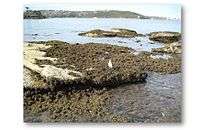Pyura praeputialis
| Pyura praeputialis | |
|---|---|
 | |
| Scientific classification | |
| Kingdom: | Animalia |
| Phylum: | Chordata |
| Subphylum: | Tunicata |
| Class: | Ascidiacea |
| Order: | Pleurogona |
| Suborder: | Stolidobranchia |
| Family: | Pyuridae |
| Genus: | Pyura |
| Species: | P. praeputialis |
| Binomial name | |
| Pyura praeputialis (Heller, 1878)[1] | |
Pyura praeputialis is an intertidal and shallow water species of tunicate. It is one of three species of "cunjevoi" in Australasia (the other two being the yellow cunjevoi P. dalbyi and the doppelganger cunjevoi P. doppelgangera). It is the first reported species of marine organism to create a "foam-nest" for its larvae.[2]
Distribution
Pyura praeputialis is common in coastal areas of the Australian mainland and ranges from southern Queensland to Cape Otway in Victoria. It is a non-indigenous species in Antofagasta, Chile.[3]
This species is an ecosystem engineer that can drastically alter habitats by overgrowing other sessile marine invertebrates. This makes it a likely problem species when introduced to new habitats.
Taxonomy
This species is part of the "P. stolonifera species complex", a group of large tunicates that are all often referred to as P. stolonifera (a species endemic to temperate southern Africa).[3] It is also sometimes called "P. stolonifera praeputialis". Compared to other species in the species complex that have onion-shaped bodies, P. praeputialis is taller, cylindrical in shape and often has a greater diameter at the top than at the base.[3]

References
- ↑ WoRMS (2012). "Pyura praeputialis (Heller, 1878)". World Register of Marine Species. Retrieved 2013-04-18.
- ↑ Castilla, Juan Carlos; et al. "Bio-foam enhances larval retention in a free-spawning marine tunicate". Proceedings of the National Academy of Sciences. 104 (46): 18120–18122. PMC 2084306
 . PMID 17984045. doi:10.1073/pnas.0708233104.
. PMID 17984045. doi:10.1073/pnas.0708233104. - 1 2 3 Rius, M.; Teske, P.R. (2011). "A revision of the Pyura stolonifera species complex (Tunicata, Ascidiacea), with a description of a new species from Australia" (PDF). Zootaxa. 2754: 27–40.